Did you know websites with a little extra code (schema markup) can jump four spots higher in search results on average? Leveraging AI-friendly schema can give you a significant edge in digital marketing. This guide explores how to use schema, with nDash.com as a practical example, to boost your website’s performance.
Understanding AI-Friendly Schema Markup
Imagine if you could give search engines a cheat sheet for your website’s content. That’s exactly what schema markup does. By adding a bit of code, you’re telling search engines what your content is about, from sizzling recipes to mind-blowing articles.
This strategic tool translates into more compelling search results, giving your website a competitive edge. Imagine star ratings for your restaurant, detailed event information, or comprehensive product descriptions. The more search engines comprehend the better they can showcase your content to users eagerly seeking what you offer.
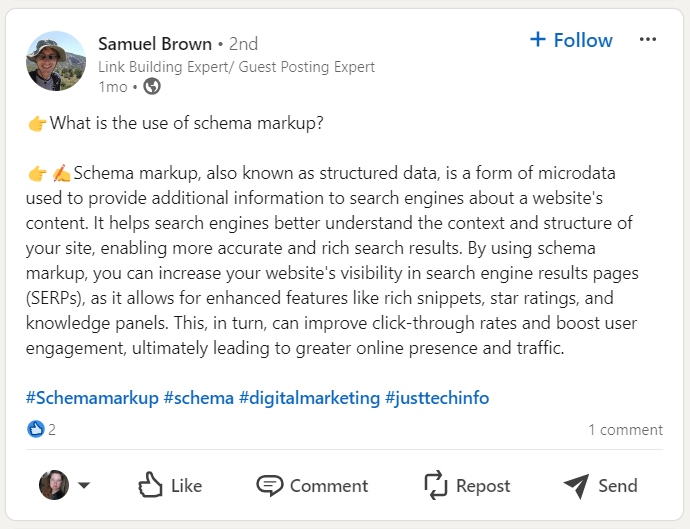
What is Schema Markup?
- Semantic vocabulary: Tags or microdata added to HTML.
- Enhanced visibility: Improves how search engines read and display your page in SERPs.
Importance of AI-Friendly Schema
Search engines are getting smarter, but they still need a little help deciphering your website’s awesomeness. That’s where schema markup comes in. Think of it as a secret language that lets search engines understand exactly what kind of content you have, whether it’s mouthwatering recipes, hilarious cat videos, or in-depth articles.
By adding some schema code (don’t worry, it’s not scary!), you unlock the power of rich search results. Imagine your listings popping up with star ratings, clear event times, or detailed product descriptions. The more search engines “get” your content, the better they can present it to users who are actively searching for what you offer.
In a nutshell, schema markup is your website’s cheat code for standing out in search results and attracting more visitors who are interested in what you offer.

Here’s why implementing an AI-friendly schema is vital for your digital marketing strategy:
Enhancing Data Accuracy
AI algorithms thrive on structured data. By using an AI-friendly schema, you ensure that your data is accurately presented and easily interpretable by search engines. This leads to more precise indexing and better search results.
An AI-friendly schema acts like a blueprint, clearly defining the format and meaning of your data. It uses specific tags and classifications that are easily recognized by AI algorithms. This allows search engines to:
- Accurately categorize your content: AI can precisely understand the type of information you’re presenting, whether it’s a blog post, product description, or scientific study.
- Extract key entities: AI can identify important details in your data, such as product names, locations, or event dates.
- AI’s ability to establish relationships between data points: AI can recognize connections between different pieces of information, enabling you to have a more comprehensive understanding of your content.
Facilitating Advanced Search Features
Modern search engines utilize AI to offer advanced features like rich snippets, knowledge graphs, and answer boxes. Implementing an AI-friendly schema increases the likelihood that your content will be featured in these prominent positions, providing greater visibility and engagement opportunities.
This includes features like:
- Rich snippets: These are condensed summaries of your content that appear directly in search results. We’ll discuss this in greater detail below.
- Knowledge graphs: Search engines use knowledge graphs to understand connections between different entities and concepts. This allows them to interpret your search query in context and potentially surface results that answer your specific question, even if the exact keywords aren’t present on the page.
- Answer boxes: These are dedicated areas at the top of search results that display concise answers to factual queries, providing users with quick and accurate information. By understanding your content through AI, search engines can determine if it’s a relevant source for these answer boxes, giving you confidence in your content’s potential reach.
Improving Semantic Search
Search engines are moving towards understanding the intent behind queries rather than just matching keywords. This is where semantic search comes in. Semantic search focuses on the meaning of words and their relationships rather than just the individual keywords themselves.
Here’s an example: Imagine a user searches for “healthy chocolate chip cookies.” A traditional keyword-based search might return results for any webpage containing those three words, regardless of whether the cookies are actually healthy. However, a semantic search engine would understand the user’s intent to find a recipe for cookies that are both delicious and good for them.
This is where AI-friendly schema becomes crucial. By implementing schema markup, you can provide search engines with the necessary context and nuances of your content. Schema acts like a bridge, allowing search engines to understand the true meaning and intent behind your web pages.
For example, using schema markup specifically designed for recipes, you can specify details like ingredients, nutritional information, and dietary restrictions. This empowers search engines to recognize your recipe content as relevant to searches like “healthy chocolate chip cookies” and potentially feature it in prominent search results.
Supporting Voice Search Optimization
With the explosion of virtual assistants like Alexa, Siri, and Google Assistant, optimizing your web presence for voice search has become essential. Voice search queries differ from traditional text-based searches because users ask questions in a more natural, conversational way.
Here’s how AI-friendly schema can help:
- Structured data for accurate results: Schema markup is your reliable ally in the SEO battle. It provides a standardized way to communicate information about your web pages to search engines. By using schema specific to voice search, you can give search algorithms a deeper understanding of your content, ensuring accurate and relevant results. This boosts your chances of securing a top spot in voice search results.
- Target conversational keywords: The key to success in voice search optimization lies in understanding your audience’s questions. People using voice search ask questions, not just keywords. Identify long-tail keywords and natural language phrases relevant to your target audience. These are more specific searches with lower competition, allowing you to attract qualified users.
- Focus on readability and clarity: Since voice assistants read your content aloud, prioritize clear, concise writing. Use short sentences and bullet points, and answer the who, what, where, when, and why of a topic directly.
Enhancing Personalization
AI-powered search engines strive to deliver personalized search results based on user behavior and preferences. Schema markup helps these algorithms understand your content at a deeper level, enabling them to match it with the right audience segments, thereby enhancing the personalization of search results.
When providing search engines with a deeper understanding of your content through schema, you can help them connect your content with the right audience segments. Here’s how it works:
- Richer user profiles: Schema markup can specify details about your content that go beyond just keywords. This could include information about a movie’s genre, the skill level required for a recipe, or the political affiliation of a news article. By understanding these details, search engines can build richer user profiles based on past interactions and preferences.
- Improved targeting: With a more comprehensive understanding of both your content and your audience, search engines can deliver more targeted and personalized results. For example, someone searching for “hiking trails” might see different results depending on their location and experience level. A beginner hiker in Boothbay, Maine, might see results for local, easy trails, while a seasoned hiker in California might see results for more challenging hikes.
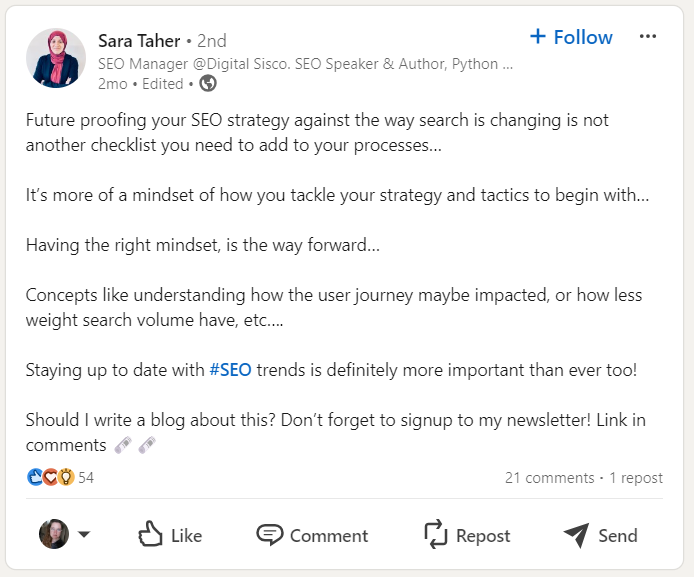
Future-Proofing Your SEO Strategy with AI-Friendly Schema
As AI continues to evolve, search algorithms will become even more reliant on structured data. By implementing an AI-friendly schema now, you are future-proofing your SEO strategy, ensuring your content remains relevant and competitive as search technology advances.
Emphasizing E-E-A-T
Integrating E-E-A-T principles into your SEO strategy is essential for maintaining high rankings and building trust with your audience. E-E-A-T, which stands for Experience, Expertise, Authoritativeness, and Trustworthiness, is a set of criteria used by Google to evaluate the quality of content.
- Experience: Demonstrate the real-world experience of content creators by showcasing relevant credentials and past work.
- Expertise: Ensure that your content is written or reviewed by experts in the field, has qualified authors, and cites reputable sources.
- Authoritativeness: Build authority by earning mentions and backlinks from other authoritative sites, including guest posting on high-authority blogs and getting cited by industry leaders.
- Trustworthiness: Increase trust by being transparent about your content creation process, displaying contact information, and having a clear privacy policy.
Regularly updating your content and adhering to E-E-A-T guidelines will help maintain your website’s authority and trustworthiness, ultimately leading to sustained high rankings and user engagement.
David Reske highlights the importance of the E-E-A-T criteria published by Google: “We think a lot about demonstrating expertise, experience, authoritativeness, and trustworthiness. Generic AI-written content doesn’t naturally do that; you have to add it carefully.”
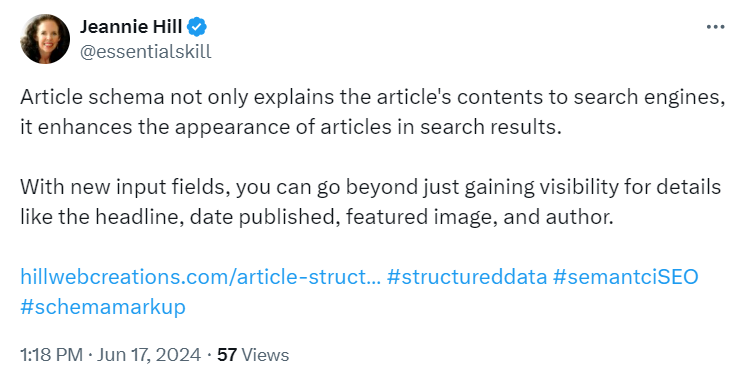
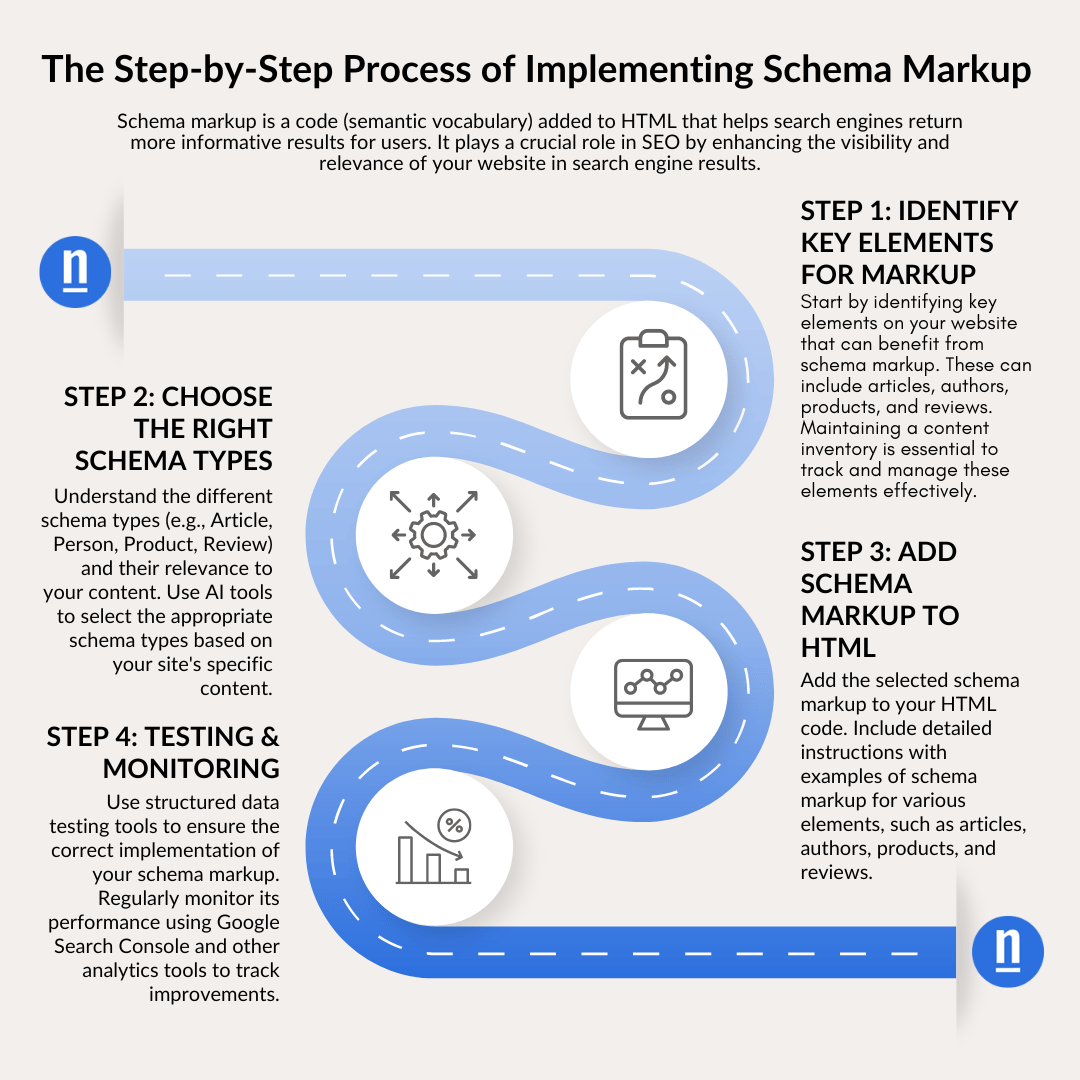
Implementing AI-Friendly Schema: A Step-by-Step Guide
While creating an AI-friendly schema for a website you manage might seem complex, it can be broken down into manageable steps. Following these steps will help search engines understand your website better, potentially leading to increased traffic.
Here’s how you can get started:
Step 1: Identify Key Elements for Markup
First, identify the elements on your website that would benefit from schema markup. For nDash.com, key elements might include:
- Articles and blog posts
- Author information
- Product and service offerings
- Reviews and ratings
To effectively identify these elements, it’s important to maintain a comprehensive content inventory. A content inventory is a detailed catalog of all your website’s content assets, including metadata, publish dates, and content formats.
By maintaining an up-to-date content inventory, you can easily track and manage your content, ensuring that all key elements are optimized with schema markup. This practice not only helps identify areas for improvement but also ensures consistency and quality across your site.
Linda Pophal notes the importance of maintaining an inventory of your content and updating it regularly. She says, “I think approaching it strategically is the best thing to do. At the outset, set up a database or system; there are tools to help. That way, you can keep an ongoing inventory or catalog of your content and when it was created.”
Step 2: Choose the Right Schema Types
Select the appropriate schema types for each element. Common schema types include:
- Article: For blog posts and news articles.
- Person: For author information.
- Product: For product and service listings.
- Review: For user reviews and ratings.
AI tools can analyze your site’s content and suggest the most relevant schema types based on the context and structure of your data. This not only saves time but also ensures that you are using the most effective schema types to enhance your SEO. Utilizing AI tools like Google’s Schema Markup Helper or other third-party software can streamline this process, making it easier to implement and manage your schema markup.
Meghan Crook Brisson shares her experience with leveraging AI tools to enhance content creation, suggesting that choosing the right tools and types can significantly improve efficiency and output (nDash.com). She explains, “I’ve leveraged tools like ChatGPT, Jasper, and others to streamline processes and inspire creativity in our campaigns.”
Step 3: Add Schema Markup to HTML
Incorporate the schema markup into your HTML. Below are specific examples for nDash.com:
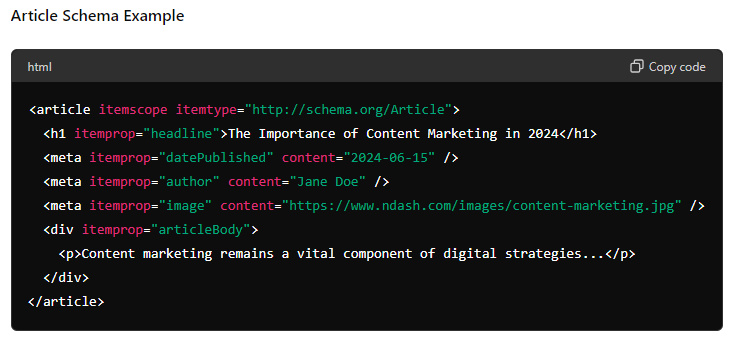
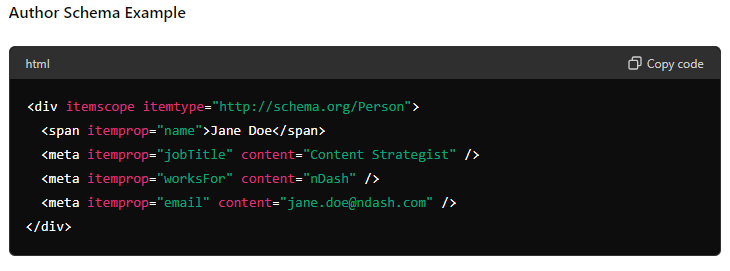
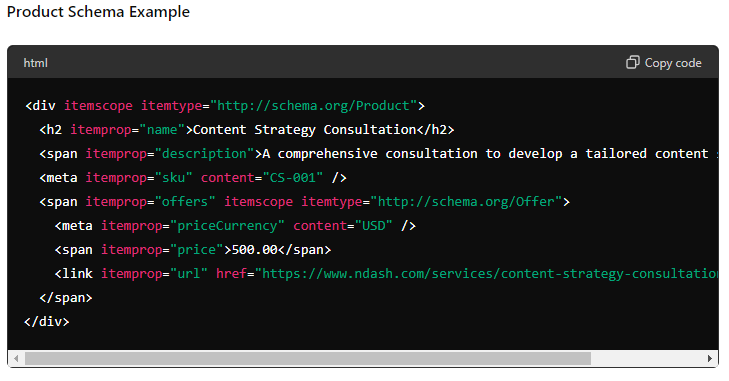
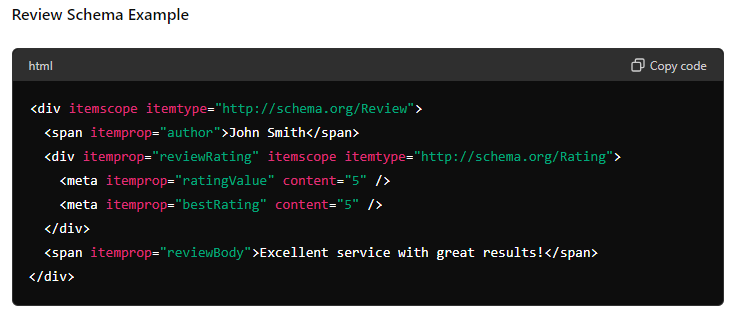
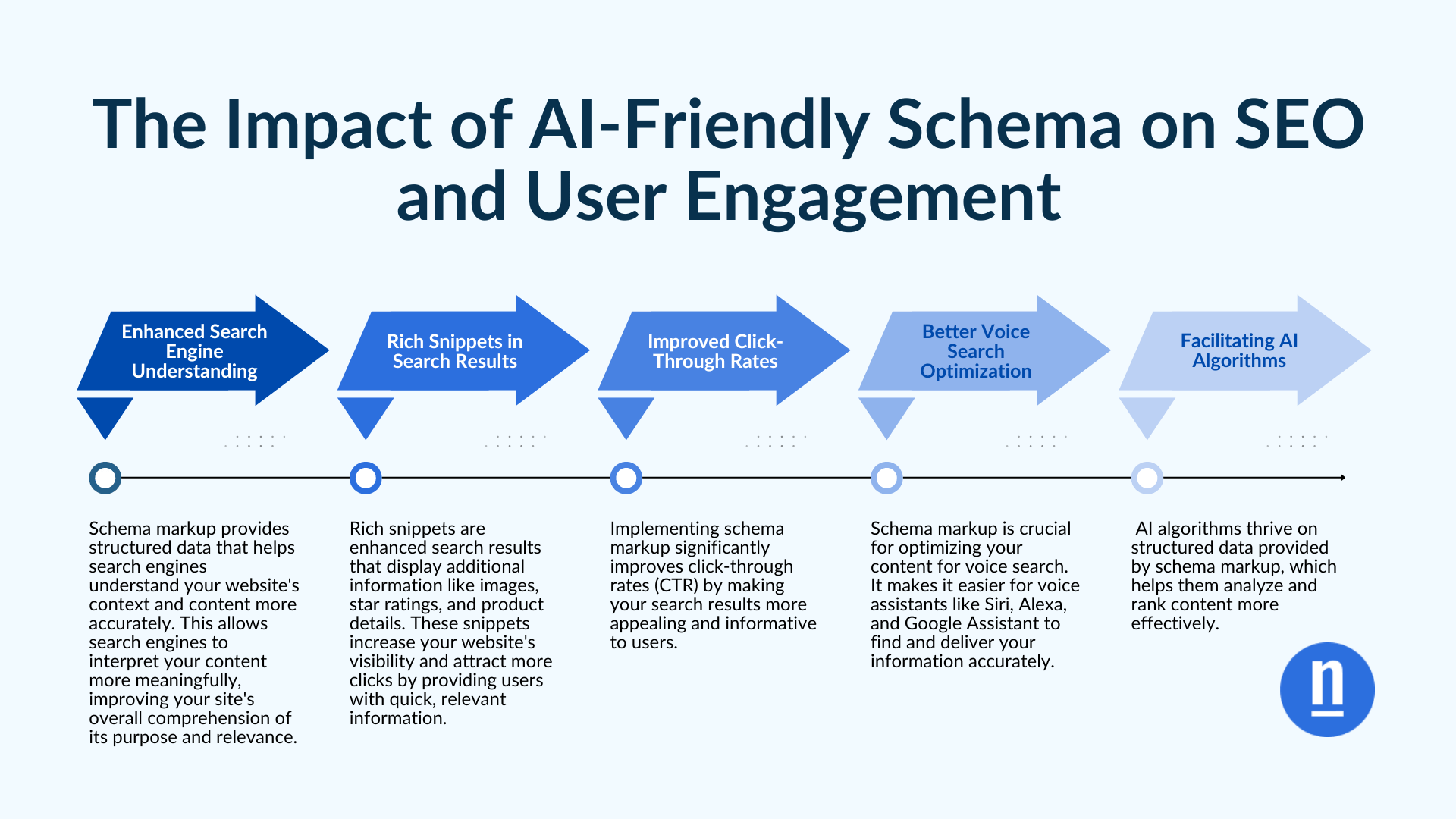
Benefits of Implementing AI-Friendly Schema
The benefits of AI-friendly schema extend beyond improved search engine understanding. Let’s explore how it can enhance various aspects of your digital marketing strategy.
Enhanced Search Engine Understanding
Search engines have become better at understanding the context and content of web pages, leading to more accurate indexing and improved ranking. By focusing on precise context and comprehensive content, websites can ensure their material is easily comprehensible by search engines, leading to better visibility and higher placement in search results.
Rich Snippets in Search Results
Rich snippets provide additional information directly on the search results page, enhancing their visibility and attractiveness. These snippets often include images, ratings, prices, or other relevant details, making the result more appealing to users. As a result, rich snippets can significantly impact click-through rates, drawing more visitors to your site’s content.
Improved Click-Through Rates
Enhanced search listings and rich snippets provide more information upfront, leading to higher user engagement. When users find the information they seek directly in search results, they’re more likely to click on your link. This improved click-through rate can drive more traffic to your site’s content, increasing the potential for engagement and conversions.
Better Voice Search Optimization
With the rise of voice search, having an AI-friendly schema can improve your website’s chances of being selected as a voice search result. Schema markup helps search engines understand your content’s context, making it more likely to be chosen for voice queries.
Facilitating AI Algorithms
Search engines use AI algorithms designed to understand and process structured data efficiently. By implementing an AI-friendly schema, you make it easier for these algorithms to analyze and rank your content, leading to better SEO performance. Additionally, having a robust content creation system in place ensures that your content remains high-quality and up-to-date, which further aids AI algorithms in accurately processing and ranking your content.
Katie Staveley from mabl discussed the benefits of having a robust system for content creation, which allowed her team to react quickly to data trends and content requests. “nDash has helped us to move faster, accelerating timelines for content in a way that allowed us to be more responsive,” she said. This mirrors the importance of regularly updating and testing your schema markup to ensure it remains effective and aligned with current SEO practices.

Best Practices for Implementing AI-Friendly Schema Markup
Struggling to get the most out of schema markup? These best practices will streamline your implementation and ensure it aligns with the latest SEO updates.
- Use structured data testing tools: Before deploying schema markup, ensure your markup is correctly implemented and error-free. Use tools like Google’s Structured Data Testing Tool or Schema.org’s validator.
- Stay updated with schema.org: Regularly check Schema.org for updates to include new schema types and properties.
- Combine schema types: Where applicable, combine multiple schema types to provide a comprehensive view of your content. For example, combine Article and Author schemas to provide detailed information about both the article and its author.
- Monitor performance: After implementing schema markup, monitor your website’s performance using tools like Google Search Console and analytics platforms. Look for improvements in search rankings, click-through rates, and overall traffic to gauge the effectiveness of your schema implementation.
The Power of AI-Friendly Schema in Digital Marketing
Incorporating AI-friendly schema into your website’s HTML is a powerful way to enhance your SEO and AI optimization efforts. Structured data clearly communicates the content of your webpage to search engines. When you use structured data, search engines can better understand your content. This data can lead to improved visibility and higher click-through rates. As digital marketers, staying ahead in the competitive online space requires leveraging every tool at your disposal. AI-friendly schema is an essential part of that toolkit.
